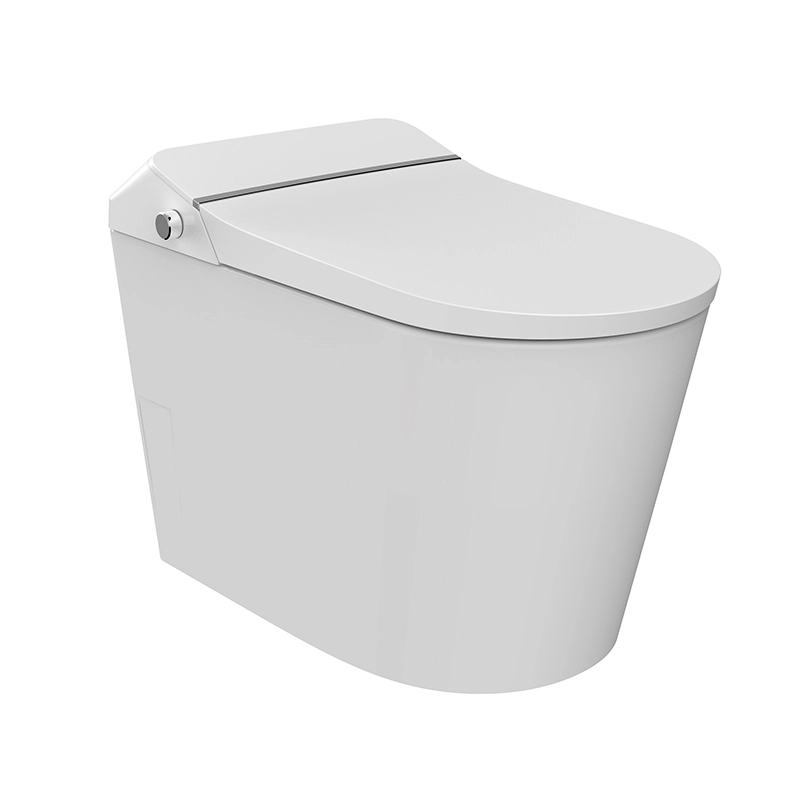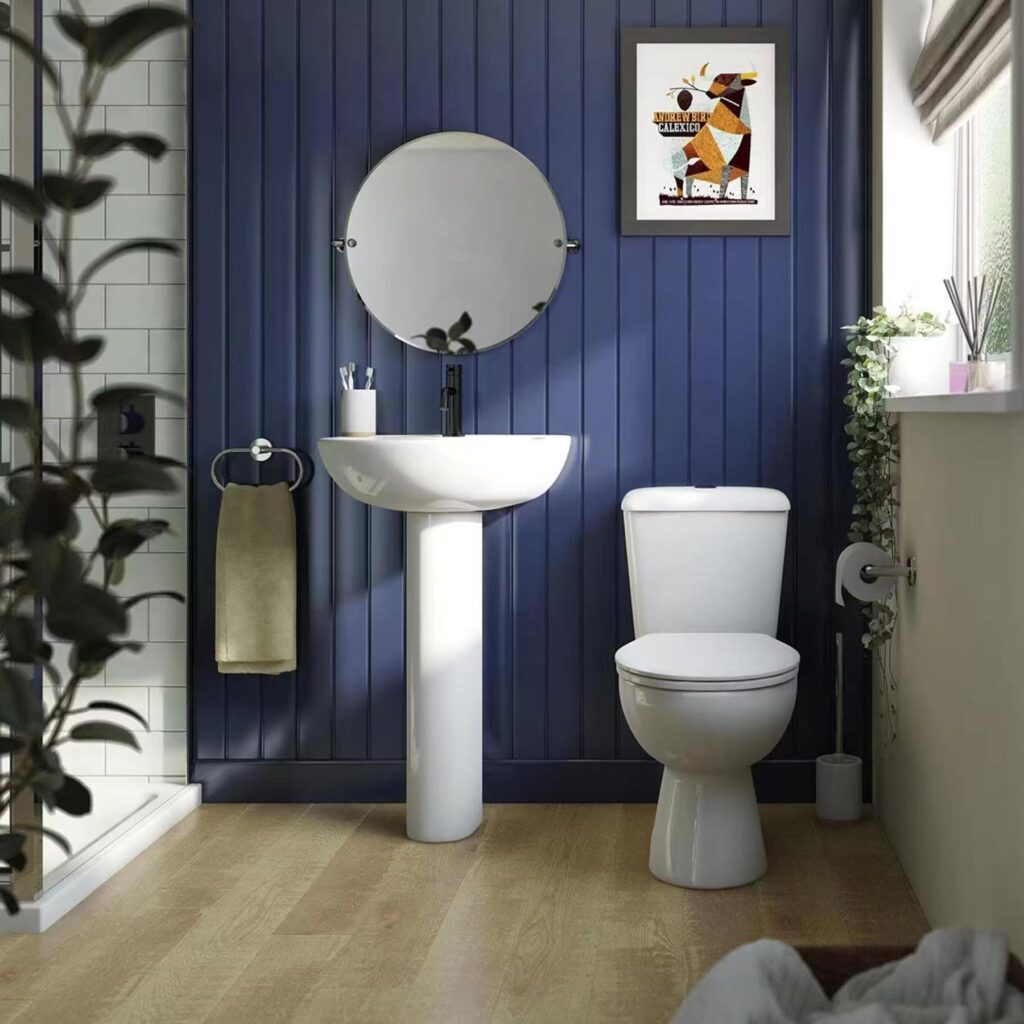Wstęp
Choosing the right toilet for your property isn’t just about flushing anymore. With smart toilets disrupting the market, property owners and developers face a crucial decision: stick with tried-and-true traditional models or invest in high-tech alternatives? This choice impacts not only user experience but also long-term costs and sustainability.
While smart toilets boast impressive features like self-cleaning capabilities and water-saving technology, they come with a hefty price tag. Traditional toilets, on the other hand, offer simplicity and affordability but may fall short on modern conveniences. As a CE-certified manufacturer of both smart and traditional toilets, we’ve seen firsthand how this decision can make or break a bathroom upgrade project.
In this guide, we’ll cut through the hype to compare smart toilets vs. traditional toilets, focusing on what matters most to homeowners, hotel operators, and commercial developers. From hygiene benefits to long-term cost implications, we’ll provide the insights you need to make an informed choice for your specific needs and budget.
Smart Toilets vs. Traditional Toilets: What’s the Difference?
When it comes to choosing between smart toilets and traditional toilets, understanding the key differences is crucial for making an informed decision. As a Ware sanitarne expert, I’m here to break down the core distinctions and help you navigate your options.
“Smart toilets offer advanced features and technology, while traditional toilets provide simplicity and reliability – each with its own set of advantages for different user needs.”
Defining Smart Toilets: Technology and Features Overview
Smart toilets are the “high-tech heroes” of the bathroom world. These modern marvels incorporate advanced technology to enhance comfort, hygiene, and efficiency. Key features often include:
- Automatic flushing systems
- Heated seats with adjustable temperature
- Built-in bidets with customizable water pressure and temperature
- Air dryers
- Self-cleaning capabilities
- Energy-saving modes
Some high-end models even offer health monitoring features, such as urine analysis for basic health checks.
Understanding Traditional Toilets: Simplicity and Functionality
Traditional toilets, on the other hand, are the tried-and-true workhorses of bathroom fixtures. They offer:
- Simple, mechanical flush systems
- Standard bowl and tank designs
- Manual cleaning requirements
- Lower initial costs
- Easier installation and maintenance
While they may lack the bells and whistles of their smart counterparts, traditional toilets are known for their reliability and straightforward operation.
Key Differences in Design and Operation
The smart toilet vs. traditional toilet comparison reveals significant differences in design and operation:
| Feature | Smart Toilets | Traditional Toilets | Impact on User Experience | Maintenance Considerations |
|---|---|---|---|---|
| Flushing Mechanism | Automatic sensors | Manual handle/button | Improved hygiene, hands-free operation | Higher complexity in smart systems |
| Cleaning | Self-cleaning features | Manual cleaning required | Reduced cleaning time for smart toilets | Traditional toilets need regular manual cleaning |
| Water Usage | Often more efficient | Standard consumption | Potential water savings with smart models | Smart toilets may require specialized maintenance |
| Comfort Features | Heated seats, air dryers | Basic seating | Enhanced comfort in smart toilets | More components to maintain in smart models |
| Energy Usage | Requires electricity | No power needed | Smart toilets add to energy consumption | Traditional toilets have no energy-related upkeep |
Why This Choice Matters for Home and Commercial Use
The decision between a smart toilet and a traditional toilet can significantly impact both residential and commercial spaces. For homes, smart toilets offer luxury and convenience, potentially increasing property value. In commercial settings, they can enhance the user experience and improve hygiene standards.
However, traditional toilets remain a cost-effective and reliable option, especially for locations with high traffic or where simplicity is preferred. The choice ultimately depends on factors such as budget, desired features, and long-term maintenance considerations.
At MFBath, we understand the importance of this decision. That’s why we offer a range of CE-certified smart and traditional toilet models, catering to diverse needs and preferences. Whether you’re looking for cutting-edge technology or classic reliability, our product lineup at https://mfbath.com/products/ has you covered.
When considering whether you should buy a smart toilet or traditional toilet, weigh the initial costs against long-term benefits. Smart toilets may offer health advantages through improved hygiene and even basic health monitoring, which could be particularly beneficial for certain users or environments.

Smart toilets offer several innovative features that set them apart from traditional toilets: 1. Hygiene features: – Self-cleaning mechanisms – Built-in bidets with adjustable water pressure and temperature – UV light sterilization for bowl disinfection – Automatic lid opening and closing 2. Comfort features: – Heated seats with adjustable temperature – Motion sensors for hands-free operation – Built-in air deodorizers – Nightlights for easy use in the dark – Customizable user profiles 3. Water efficiency: – Dual flush systems with precision control – Lower flush volumes (0.8-1.28 gallons vs 1.6 gallons for standard toilets) – Automatic flush activation to prevent over-flushing – Built-in leak detection 4. Smart features: – Touchless operation – Adjustable water pressure – Integration with smart home systems While smart toilets offer many benefits, they do have some drawbacks such as higher initial costs and the need for electricity. However, for many users, the long-term advantages in hygiene, comfort, and efficiency outweigh these considerations. MF Bath’s smart toilets incorporate many of these features, making them particularly attractive for hotels and eco-conscious developers. The company also offers comprehensive after-sales support to ensure long-term reliability.
When comparing the cost of smart toilets vs traditional toilets, there are several factors to consider: 1. Upfront cost: – Smart toilets: Generally range from $500 to $5,000+ – Traditional toilets: Typically $100 to $1,000+ 2. Water efficiency: – Smart toilets: Often use 0.8 to 1.28 gallons per flush – Traditional toilets: Usually use 1.6 gallons per flush 3. Long-term savings: – Smart toilets can lead to lower water bills due to increased efficiency – Some models have self-cleaning features, potentially reducing maintenance costs 4. Lifespan: – Smart toilets: 10-20 years on average – Traditional toilets: 10-15 years on average 5. Maintenance: – Smart toilets may have higher repair costs for electronic components – Traditional toilets generally have lower maintenance costs While smart toilets have a higher upfront cost, they can offer long-term savings through water efficiency and added features. Traditional toilets are more budget-friendly initially but may cost more in water usage over time. For commercial projects, smart toilets often provide better ROI due to their durability and efficiency. MF Bath offers CE-certified options for both types, with warranties to ensure cost-effective solutions for various needs and budgets.
Pros and Cons: Weighing Your Options
When considering a smart toilet vs. traditional toilet, it’s essential to weigh the advantages and disadvantages of each option. As an industry expert, I’ll break down the key factors to help you make an informed decision based on your specific needs and priorities.
“Both smart toilets and traditional toilets have their unique strengths and weaknesses, making the choice dependent on individual preferences, budget constraints, and specific use cases.”
Smart Toilet Pros: Hygiene, Comfort, and Efficiency
Smart toilets offer several advantages that make them an attractive option for many users:
- Enhanced hygiene with self-cleaning features and touchless operation
- Improved comfort with heated seats and personalized settings
- Water efficiency through precise flushing mechanisms
- Advanced features like built-in bidets and air dryers
- Potential health monitoring capabilities
These benefits make smart toilets particularly appealing for luxury homes, high-end hotels, and health-conscious individuals.
Smart Toilet Cons: Higher Costs and Installation Complexity
Despite their advantages, smart toilets do have some drawbacks:
- Higher upfront costs compared to traditional toilets
- More complex installation requiring electrical connections
- Potential for technical issues and higher repair costs
- Dependence on electricity for full functionality
These factors may make smart toilets less suitable for budget-conscious projects or areas with unreliable power supply.
Traditional Toilet Pros: Affordability and Simplicity
Traditional toilets continue to be popular due to their:
- Lower initial purchase and installation costs
- Simplicity in design and operation
- Reliability and ease of maintenance
- Familiarity for most users
- No dependence on electricity
These attributes make traditional toilets a “solid choice” for many residential and commercial applications.
Traditional Toilet Cons: Maintenance and Limited Features
However, traditional toilets do have some limitations:
- Manual cleaning requirements
- Lack of advanced comfort features
- Potentially higher water consumption
- Limited customization options
These factors may make traditional toilets less appealing for those seeking luxury or maximum efficiency.
| Feature | Smart Toilets | Traditional Toilets | Impact on Decision | MFBath Options |
|---|---|---|---|---|
| Initial Cost | $500 – $5000+ | 100 USD – $1000 | Budget considerations | Range of price points available |
| Wydajność wody | High (0.8-1.28 gpf) | Moderate (1.6 gpf) | Long-term savings potential | Both efficient models offered |
| Maintenance | Complex, potentially costly | Simple, generally affordable | Long-term care considerations | Support for all models |
| Hygiene Features | Advanced (self-cleaning, touchless) | Basic | Health and cleanliness priorities | Various hygiene options available |
| Installation | Complex (requires electricity) | Simple (plumbing only) | Installation complexity and cost | Professional installation support |
When comparing smart toilet vs. traditional toilet options, consider your specific needs, budget, and long-term goals. Smart toilets align well with commercial sustainability trends and luxury residential projects, while traditional toilets suit budget-conscious applications and simpler installations.
At MFBath, we understand that every project has unique requirements. That’s why we offer a diverse range of CE-certified smart and traditional toilets, catering to various preferences and budgets. Our commitment to quality and customer support ensures you’ll find the right solution, whether you prioritize cutting-edge features or classic reliability.

Making the Decision: Which Toilet Fits Your Needs?
When it comes to choosing between a smart toilet vs. traditional toilet, there’s no one-size-fits-all answer. Your decision should be based on your specific needs, budget, and priorities. Let’s break down the key considerations for different user groups to help you make an informed choice.
“The right toilet choice depends on your specific needs – balancing comfort, efficiency, and budget to find the perfect fit for your bathroom.”
Best for Homeowners: Balancing Budget and Comfort
For homeowners, the decision often comes down to balancing comfort features with budget constraints:
- Traditional toilets: Ideal for budget-conscious homeowners or those who prefer simplicity
- Smart toilets: Perfect for those seeking luxury, enhanced hygiene, and water efficiency
Consider your long-term plans. If you’re planning to sell soon, a smart toilet could be a unique selling point. For a forever home, the comfort features might be worth the investment.
Ideal for Hotels: Enhancing Guest Satisfaction
For hotel owners, the choice can significantly impact guest experience:
- Smart toilets: Offer a “wow factor” and enhance perceived room value
- Traditional toilets: Reliable and cost-effective for budget accommodations
Luxury hotels might benefit more from smart toilets, while budget-friendly establishments could stick with high-quality traditional models.
Optimal for Developers: Sustainability and Scalability
Commercial developers need to consider long-term value and sustainability:
- Smart toilets: Align with green building trends and can be a selling point for eco-conscious buyers
- Traditional toilets: Offer cost-effective solutions for large-scale projects
The choice may depend on the project’s target market and sustainability goals.
Procurement Tips: Availability, Service, and Returns
When making your final decision, consider these procurement factors:
| Factor | Smart Toilets | Traditional Toilets | MFBath Advantage |
|---|---|---|---|
| Availability | May have longer lead times | Usually readily available | Fast delivery on both types |
| Service Support | May require specialized technicians | Widely available service | Comprehensive support for all models |
| Return Policy | Often more restrictive | Generally more flexible | Favorable return policies for both |
| Bulk Ordering | May offer tech integration benefits | Often more cost-effective | Scalable solutions for large projects |
| Health Benefits | Enhanced hygiene features | Standard hygiene | Options for health-conscious buyers |
Should you buy a smart toilet or traditional toilet? The answer depends on your specific situation. For those prioritizing advanced features and willing to invest, smart toilets offer unparalleled comfort and efficiency. If budget and simplicity are your main concerns, a high-quality traditional toilet might be the better choice.
At MFBath, we understand the importance of this decision. That’s why we offer a wide range of CE-certified smart and traditional toilets to suit various needs and budgets. Our product lineup, available at https://mfbath.com/products/, includes options for both residential and commercial applications. With our fast delivery, comprehensive support, and favorable return policies, you can make your choice with confidence.
Remember, the smart toilet vs. traditional toilet debate isn’t just about technology – it’s about finding the right fit for your lifestyle, budget, and long-term goals. Whether you’re a homeowner looking to upgrade your bathroom, a hotel owner aiming to enhance guest satisfaction, or a developer focusing on sustainability, MFBath has the perfect solution for you.
Wniosek
After years in the sanitary ware industry, I’ve seen firsthand how the right toilet can transform a bathroom experience. Whether you’re drawn to the high-tech allure of smart toilets or the reliable simplicity of traditional models, the key is matching your choice to your specific needs and budget.
Smart toilets offer unparalleled comfort and efficiency, making them a **”Przełapanie gry”** for luxury homes and high-end hotels. But don’t count out traditional toilets—their affordability and straightforward design still make them a solid choice for many projects.
Ultimately, the smart vs. traditional debate isn’t just about features—it’s about finding the perfect fit for your lifestyle or business. Whatever you choose, remember that quality and support matter. That’s why at MFBath, we’re committed to providing top-notch options for both, ensuring you’ll flush away your worries, not your investment.
FAQ
-
Q1: What are the main differences between smart toilets and traditional toilets?
A1: Smart toilets feature advanced technology such as bidet functions, automatic flushing, and self-cleaning mechanisms, while traditional toilets rely on manual operation and gravity for flushing.
-
Q2: Are smart toilets worth the investment compared to traditional toilets?
A2: While smart toilets generally have a higher upfront cost, they offer benefits like improved hygiene, comfort features, and potential savings on water bills, making them a worthwhile investment for many homeowners.
-
Q3: What are the advantages of using a smart toilet?
A3: Smart toilets provide enhanced hygiene through self-cleaning, integrated bidet functions, and deodorizing features, while also offering comfort items like heated seats and customizable settings.
-
Q4: How do smart toilets help save water?
A4: Many smart toilets are designed to use less water per flush compared to traditional toilets, resulting in lower water bills and a more environmentally-friendly bathroom option.
-
Q5: What are the common features of smart toilets?
A5: Common features of smart toilets include heated seats, automatic flushing, adjustable water temperature and pressure, bidet functions, self-cleaning capabilities, and deodorization.
-
Q6: Do smart toilets require more maintenance than traditional toilets?
A6: Smart toilets may require specialized maintenance due to their electronic components, but their self-cleaning capabilities often reduce the frequency of manual cleaning.
-
Q7: Can smart toilets improve hygiene compared to traditional toilets?
A7: Yes, smart toilets often include integrated bidets, adjustable cleaning features, and self-cleaning functions, all of which enhance hygiene and reduce the need for manual cleaning.
-
Q8: What factors should I consider when choosing between a smart toilet and a traditional toilet?
A8: Consider your budget, preference for convenience and hygiene features, any specific bathroom needs, and the potential long-term savings on water bills when deciding between smart and traditional toilets.
Linki zewnętrzne
- Smart Toilets vs. Traditional Toilets: Which Should You Choose?
- What Is a Smart Toilet and Should You Buy One?
- Smart Toilets vs. Traditional Toilets: Which is the Better Investment?
- Modern Smart Toilets vs Traditional Toilets — What’s the Difference?
- Smart Toilet Buying Guide
- Smart Bidet Toilet vs Traditional Toilet
- How Does a Smart Toilet Work and How to Use It?
- Are Smart Toilet Bowls Worth the Investment?







